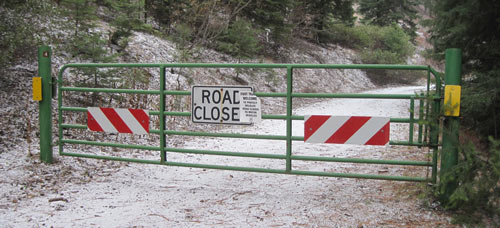Archive for category Colorado Politics
Is The Right Finally Getting Smart About Ballot Measures?
Posted by Joshua Sharf in Colorado Politics on October 13th, 2016
 Maybe they are.
Maybe they are.
Watching the Rangers-Blue Jays game the other night, I saw a commercial against Colorado’s Amendment 72, an initiative to amend the state Constitution to raise the tobacco tax from 84 cents a pack to $2.59 a pack.
The main stated argument in favor is that such a high tax will reduce underage smoking, and the money is supposed to go to programs to do that, along with a wish-list of other tangentially-related health expenditures, such as money for hospitals and student loan relief for rural doctors.
What was striking was that the language was almost identical to a radio ad I had heard earlier in the week opposing California’s Proposition 56, which would raise its cigarette tax from $0.87 to $2.87. The tax-raisers in California are evidently using the same arguments as the ones here in Colorado.
It may be that the Right is finally figuring out that it needs a national effort to combat state-level bad ideas. Since the language used in the anti-referendum ads was so similar, I can only assume that they were a coordinated response. Given the electoral environment in both Colorado and California, I’m not optimistic about defeating these taxes in either states, but I hope that they don’t take the wrong lessons from it and give up.
Coordination is nothing new for nationwide liberal interest groups. They routinely find promising states to run similar legislation or ballot initiatives in, coordinating their efforts nationally, and running similar ad campaigns. (For instance, former New York Mayor Michael Bloomberg is running spots in favor of a 1-cent soda taxes in both San Francisco and Oakland this year.) Then, having established bona fides, they move onto other states. California and Colorado are both targeted for tobacco tax increases because they’ve “fallen behind” other states in how much they let their non-smokers translate their feelings of moral superiority over smokers into action.
Historically, they’ve relied on conservative state-level think tanks and political groups not to realize that any given initiative or legislation wasn’t unique to their state.
In recent years, the right has gotten wise to this strategy, although it’s been somewhat ineffective in countering it. As out-of-state funding is almost always unpopular, the Left has countered efforts to highlight that by filtering contributions through its networks of state and local PACs and issue committees. When I worked at Watchdogwire.com, one of the mantras among the state editors was, “If it’s happening in your state, it’s happening in other states.” This helped give us the incentive to write certain stories, but getting people to read them and connect them to what was not yet going on locally was another matter.
In addition, when more conservative-minded groups such as ALEC or the State Policy Network of state-level policy groups have tried the same thing, they’ve been attacked as conspiracies by the left, and their sponsors and donors have been the targets of hate campaigns.
I found the arguments opposed to the tax compelling. Both Colorado and California have already diverted alleged anti-tobacco money to other purposes, and in any event, after the first year, you never really know how much money is “supposed” to go to these programs, anyway, so any tax increase really becomes an excuse for the state spend on whatever it likes (and more importantly to the politicians, whomever it likes). This was the logic that helped defeat a large general income tax increase back in 2013, although cigarette smokers are always an attractive target for tax increases.
Although I don’t smoke, don’t use tobacco, and despite being from Virginia, never have, I think I’ll vote against giving the government more money to spend.
Podcast #2 – BLM Road Closures
Posted by Joshua Sharf in Colorado Politics on October 11th, 2015
 Marjorie Haun has been doing yeoman work following the story of the BLM land closures. In this podcast, I talk to some of the players – a business-owner whose customers will find themselves with less road to ride; an activist who’s working the legal side; and a member of the Mesa County Board of Commissioners who filed a protest.
Marjorie Haun has been doing yeoman work following the story of the BLM land closures. In this podcast, I talk to some of the players – a business-owner whose customers will find themselves with less road to ride; an activist who’s working the legal side; and a member of the Mesa County Board of Commissioners who filed a protest.
In the story, we reference the BLM’s Resource Management Plan. You can find the map of it here.
And a copy of the form letter protest denial can be found here.
Marjorie has filed two stories on the planned closures, one in May, one in September.
Podcast: Play in new window | Download
Podcast Experiment
Posted by Joshua Sharf in PERA, Radio, Stacy Petty Show on September 30th, 2015
 One of my fondest desires has been to produce a This American Life or RadioLab, only for free-market and conservative ideas. Thanks to Stacy Petty, I’ve actually been given a chance to do this.
One of my fondest desires has been to produce a This American Life or RadioLab, only for free-market and conservative ideas. Thanks to Stacy Petty, I’ve actually been given a chance to do this.
In one of his own podcast interviews, Dan Carlin of Hardcore History fame says that his goal has been to produce, for radio, a long-form edition of what a newspaper column would look like. That’s kind of what I’m aiming for here, as well. Edited, polished, but also using the illustrative and mood-setting background sound that radio give you, but newspapers don’t.
It’s unclear exactly what the format will be going forward, but here’s the first attempt, discussing PERA, the forthcoming State Auditor’s report on an early warning system, and small planes. It runs 10:30, but I’m hoping to bring future editions in at exactly 10:00.
Podcast: Play in new window | Download
Call Western Union
Posted by Joshua Sharf in 2016 Presidential Race, Governor 2010 on August 11th, 2015
 “If you want to send a message, call Western Union.” – Samuel Goldwyn
“If you want to send a message, call Western Union.” – Samuel Goldwyn
Much if not all of the Trump boomlet is fueled by a frustration with and distrust of a party establishment that seems not only cozy with progressives, but comfortable with progressivism. Articles by both Reihan Salam and Glenn Reynolds have made this point, and it’s one that Mark Steyn has talked about. Americans are happy to play politics between the 40-yard-lines. Given a perpetual choice between 49-yard-lines, though, they rebel.
The problem is that this rebellion isn’t necessarily coherent, and is usually destructive. In 1968, Democrats sent a message to Lyndon Johnson, and got Richard Nixon elected. In 1992, Republicans sent a message to George H.W. Bush in the form of Pat Buchanan, and got Bill Clinton elected.
A close analogy is here in Colorado in the 2010 governor’s race. Unpopular incumbent Democrat Bill Ritter decided not to run for re-election amid rumors of personal scandal. The Republicans, with festering dissatisfaction at the “establishment” after losing marquee statewide races in 2004, 2006, and 2008, had a choice between stalwart conservative, but presumed establishment favorite, Rep. Scott McInnis of Glenwood Springs, and unknown, blank-slate, self-professed Tea Party businessman Dan Maes. When fellow Republicans satisfied a personal vendetta by leaking allegations of plagiarism just before the primary election, many Republicans registered their complaints by either not voting for McInnis or voting for Maes, who squeaked by with a major upset win.
The other factor was a widespread, small-l libertarian-fueled distrust and honestly hatred of the party officials and party officialdom. I was at Denver party breakfasts in 2008 when Dick Wadhams was raked over the coals by the Ron Paul people, and that resentfulness has percolated (and been stoked by the large-l Libertarians) ever since. It certainly was around in 2010.
Maes, frankly, had no business being the nominee, and no business being a statewide candidate. He had no idea what he was doing, no interest, apparently, in the nuts and bolts of an active campaign, no willingness to spend endless hours on the phone raising money. And the Republican party blew as good an opportunity as we ever had in the Tea Party year of 2010 to reassert control over state government.
The current national dynamics eerily and scarily resemble those of 2010 here in Colorado. Candidates actually capable of uniting the various factions of the party, or bringing a unique and valuable message, are getting shut out of the process because it’s All Trump All The Time.
While I remain convinced that there’s no way on God’s green earth the party will actually nominate Donald Trump as its presidential candidate, he’s sucking oxygen from as deep and talented a field as I’ve seen in my lifetime at the national level.
That depth, by the way, is also in large part the result of a 20-year effort to grow the party at the state legislative level. It’s meant letting each state party find its way and find horses for courses, as the saying goes. That’s resulted in Republican government in states as diverse as Michigan and Alabama, but it’s also meant that those state parties differ much more from each other than they might once have. The only person capable of uniting a national party is a presidential candidate, and the nominating process is a means of having the debate to decide where we want to go nationally.
A political party is a coalition of diverse interests, but there are elements outside the party who can’t stand that fact, and would be perfectly delighted to see the national party dissolve into factional bickering and resentfulness. There’s absolutely no good reason to let that happen, or to nominate less than our best this year.
Colorado to Pay for Drunken Artists Colonies
Posted by Joshua Sharf in Budget on July 28th, 2015
In wha t has to be one of the worst misappropriations of public funds since that study about why lesbians are fat, Colorado is going to sponsor “affordable housing” (sic) for artists in rural communities:
t has to be one of the worst misappropriations of public funds since that study about why lesbians are fat, Colorado is going to sponsor “affordable housing” (sic) for artists in rural communities:
Gov. John Hickenlooper announced the plan Monday at an artists’ community in Loveland. The governor says that the state will help sponsor a $50 million plan to create artist housing in nine rural communities, starting with Trinidad.
Why should Denver have all the bad public art?
The housing will have income caps. Artists who qualify for housing can’t make more than 60 percent of their area’s median income.
Well, at least we have some standards.
Private foundations are joining the effort. A state spokeswoman says it’s not clear how much of the $50 million will be paid by the government.
How about $0? Does $0 work for you?
The program will have a generous definition of “artist.” The program will accept architects, filmmakers – even beer and liquor makers.
Gotta get those creative juices flowing somehow.
The argument we hear from the Democrats all the time is, “We need to have a conversation about what we want the government to do, and then fund it appropriately.” This is the sort of nonsense you get when you start from that end of the deal. Of course when you start by asking, “What is it you want?” you end up with a wish list like me in a book store. The phrasing completely hides the fact that you’re actually making choices – either about what the government will do with its limited resources, or with what you can do with your own.
Try phrasing it differently: “We need to decide how much we really want to pay for government, and then use that money appropriately.” Aha, now it’s clear that there’s only so much money to go around, and if you want to spend your own money on this sort of thing, you’ll be paying for it before you fund your food, your mortgage, your kids’ education, and your retirement.
Naturally, the Democrats hate that part of the conversation, so much so that they try, every step of the way, not to let you have it. They want to have the “What do you want us to do for you?” part of the discussion, and then, once you’ve committed to buying Pierre the Failed Art Student his rent and bitters, tell you how much it costs. And when you decide maybe your dental bill is more important, they want to insist that, no, we’ve already decided that IPAs for Pierre are in the budget, and it’s no fair going back on that and changing the deal on poor Pierre, once he’s pulled up stakes and moved to Ouray.
It’s the main reason they hate TABOR so much. Unless it’s a really good budget year, and the government just happens to have money sitting around burning a hole in its pocket, TABOR makes them actually ask you whether or not you want to pay for Pierre’s studio loft.
The next time someone comes up with a harebrained idea like this, the first question should be: “Instead of what?”
As Colorado’s Pensions Add Risk, California Seeks to Reduce It
Posted by Joshua Sharf in PERA on July 26th, 2015
 Even as Colorado’s state public pensions seek to add risk to their portfolio, California CalPERS is seeking to reduce risk and volatility in its own plan. In doing so, it sends up a flare for other pension plans. It also confirms one of the key assertions of defined benefit plan critics: the aggressive return assumptions, combined with permissive discount rate assertions, in US public pension plans incentivize those plans to chase those returns, and add risk in doing so.
Even as Colorado’s state public pensions seek to add risk to their portfolio, California CalPERS is seeking to reduce risk and volatility in its own plan. In doing so, it sends up a flare for other pension plans. It also confirms one of the key assertions of defined benefit plan critics: the aggressive return assumptions, combined with permissive discount rate assertions, in US public pension plans incentivize those plans to chase those returns, and add risk in doing so.
In a piece I wrote back in March for Watchdog Arena, I noted that Colorado PERA’s Board of Trustees had voted to shift several percentage points of investment from stocks and bonds into riskier alternative assets and real estate. This portfolio isn’t necessarily out of line with the majority of US public pension asset allocations, but it does represent adding risk – and therefore volatility – in an attempt to increase returns.
Yesterday, Pensions and Investments reported that CalPERS is looking at reducing its expected 7.5% rate of return to as low as 6.5%. Doing so, the plan says, would allow it to shift its investments out of stocks and alternative assets into more predictable, less volatile bonds.
“It is essential that we do this,” said California Controller Betty T. Yee in an interview with P&I. Ms. Yee added that if CalPERS does not reduce volatility, it could jeopardize its ability to pay retirees in the future….
Ms. Eason said lowering the rate of return would also enable officials to build a portfolio less vulnerable to market swings. The current 7.5% rate of return has a 12% volatility rate. Reducing the rate to 7%, as one scenario does, would translate to a 10% volatility rate. A 6.5% rate of return would equate to a volatility level of 8.5%, she said.
In doing so, CalPERS doesn’t implicitly accept the critics’ assertions – it explicitly accepts them. They would lower the expected rate of return specifically so they could “safely” move assets into less risky (albeit less remunerative) investments. Public pension officials in the US have long denied a linkage between the two, so it will be interesting to see how they react to this admission.
By most measures, CalPERS is better funded that Colorado PERA, although not particularly well-funded. It admits to a funding level of 77%, compared to PERA’s claimed funding level of 62%. These claims both discount the pension liabilities at 7.5%, the assumed rate of return. Lowering CalPERS’s expected rate of return to 6.5% would, correspondingly, lower its funded level by lowering its discount rate. A study by State Budget Solutions, however, using the states’ cost of borrowing as the discount rate, placed the funding levels at 39% and 32%, respectively.
PERA’s 2014 CAFR – Situation Normal…
Posted by Joshua Sharf in PERA on June 23rd, 2015
Colorad o PERA released its 2014 Comprehensive Annual Financial Report on Tuesday, and there were no real surprises, which isn’t to say it was particularly good news for the state’s retirees, government employees, or taxpayers. For the most part, it showed more of what we already knew: a system in trouble, and unlikely to earn its way out of that trouble any time soon, if ever.
o PERA released its 2014 Comprehensive Annual Financial Report on Tuesday, and there were no real surprises, which isn’t to say it was particularly good news for the state’s retirees, government employees, or taxpayers. For the most part, it showed more of what we already knew: a system in trouble, and unlikely to earn its way out of that trouble any time soon, if ever.
The rate of return on investment was 5.7%, which is 1.8% short of the expected rate of return of 7.5%. PERA will no doubt point to the fact that it met the benchmark return, but all that means is that the funds weren’t grossly mismanaged. The net result is that the unfunded liability, as acknowledged by PERA, climbed from $23.3 billion to $24.6 billion.
In reality, the future liability should be discounted not at the expected rate of return – an accounting gimmick that is only available to US public pensions – but by the borrowing cost of the governments involved. In this case, that would mean a discount rate of about 4.5%. Running that out 15 years, we end up with an eye-popping unfunded liability of $60 billion. A 30-year window raises it to an almost unimaginable $116 billion. That’s the unfunded liability – the promises made for which we have no money.
Overall, the funding levels fell to 64.2% from 65.2%, but the two biggest funds are much worse off than that. The State Fund’s funding level slipped to 59.8%, the School Fund to 62.8%. These calculations are done using the market value of the assets, rather than the smoothed actuarial value, as they have in the past. That actually makes the funding levels look better, as the investments age out the miserable 2011 investment year, but it gets the direction right, and funds can only spend and invest actual dollars, not smoothed ones.
The amortization periods – how long it would take to get to full funding – also ballooned to 45 years for the State Fund, and 48 years for the School fund, after accounting for the future increases in the AED and SAED supplemental payments. PERA rightly points out that these numbers don’t account for the decrease in benefits for future hires, which probably shorten the amortization periods by a few years.
I’ll have a lot more to say about this, but the short version is that there’s nothing to be cheerful about here. PERA will claim that everything is still on track to be fully-funded decades hence, but then, PERA always thinks nothing’s wrong right up until the point that they come to the legislature for more money.
Photo Credit: Todd Shepherd & Complete Colorado
Media 101
Posted by Joshua Sharf in Colorado Politics, PERA on June 4th, 2015
 When the PERA Pension Obligation Bond story was in its death throes, the Denver Post was writing a story about the political, rather than the financial angle, of the bill and its failure in committee. Treasurer Walker Stapleton had testified in favor of the bill in the House Finance Committee, although most of his testimony was of a technical nature.
When the PERA Pension Obligation Bond story was in its death throes, the Denver Post was writing a story about the political, rather than the financial angle, of the bill and its failure in committee. Treasurer Walker Stapleton had testified in favor of the bill in the House Finance Committee, although most of his testimony was of a technical nature.
At the time Post reporter John Frank called me, I had not yet heard Stapleton’s comments on the Mike Rosen Show, where he appeared to try to walk back his support for the bill. There’s no reason to rehash the controversy here, and that’s not the point of the post.
The point is this: Franks paraphrased what Stapleton had said, and asked me to comment on his on-air statements. I asked him to quote them to me. He quoted to me a couple of sentences, and I was brought up short. But this was a radio talk show, and Mike Rosen is one of the best interviewers around. The actual on-air back-and-forth was much longer than that.
So I paused, said that, even though I had just asked him to quote Stapleton to me, I really would need to hear the whole thing before I could comment. And I went on to say something Franks probably already knew – that there were legislators without pension funding expertise who had probably been swayed by Walker’s support, and by the fact that the Republican Treasurer, Democrat Governor, and “impartial” PERA Board were all in favor of the deal.
Later, after thinking about it, I came back with what I expressed as a possible interpretation of what Frank had quoted me, didn’t offer an opinion on it, and suggested he go back and listen to the whole interview with that idea in mind.
Reporters often count on people liking to talk, and liking to talk to reporters specifically, because they may get to see their names in print. But you don’t have to answer a question if you don’t want to, and you don’t have to offer an opinion when the only information you’re getting is from the reporter.
I doubt Frank was purposely trying to do a hatchet job on Walker, but there was no reason to fall into the trap of trying to offer an opinion based on an interpretation of one small piece of the story.
PERA’s Pension Obligation Bonds Are a Bad Idea
Posted by Joshua Sharf in PERA on May 21st, 2015
This is an extended version of the OpEd that appeared in the Greeley Tribune.
Last week, Colorado legislators considered – and rejected – a plan of dubious legality to shore up the state’s public pensions.
The result of a difficult three-way negotiation among Governor Hickenlooper, Treasurer Stapleton, and PERA, the plan would have circumvented the state Constitution’s limits against issuing general obligation debt without a vote of the people, for gains that would have been largely illusory.
Worse, the changes could have encouraged future legislatures to repeat mistakes that put teachers’ and state employees’ retirements at risk in the first place, while making real reforms more difficult.
HB15-1388 would have authorized the State Treasurer to direct the Colorado Housing and Finance Authority (CHFA) to issue up to $10 billion in bonds on the state’s credit. The proceeds would have been deposited into PERA’s State and School funds, and invested with the rest of PERA’s assets. The investment returns theoretically would shorten PERA’s time to full funding.
The bonds’ interest was to be funded by the supplemental payments that the state and school districts pay into PERA (the AED and SAED), with PERA paying back the principal when the bonds matured. The AED and SAED payments are taxpayer contributions established in 2004 and 2006 to stabilize PERA’s finances. They are escalating percentages of employee salaries.
The complex web of relationships was needed to avoid state constitutional limits on issuing debt. The bill’s language laid out the legal arguments for why the restrictions didn’t apply. Supporters claimed they were revenue bonds that would not obligate general tax dollars, and purported that CHFA is not a state agency.
Passing the buck to the courts, HB 1388 would have required a binding judicial ruling certifying the scheme’s legality before the bonds could have been issued.
Make no mistake: The debt would have been on the state’s credit, and shown up on the state’s balance sheet. These are not revenue bonds; they would have been funded only by general tax revenue.
Whether or not the game of hide-the-pea satisfied the courts, it violated the spirit and purpose of constitutional provisions designed to prevent the legislature from indebting citizens into a long-term fiscal bind. The many state bankruptcies of the 1840s were still fresh in the people’s minds in 1876, when the Constitution was drafted. Those concerns are no less valid now.
The bonds wouldn’t have shown up in PERA’s financial report, except in the footnotes. With no single, authoritative document laying out the full financial picture associated with funding the state’s public pensions, PERA would look better-funded than it was.
Risk-averse legislators could have justified avoiding the difficult decisions needed to provide real retirement security for Colorado’s teachers and state employees. Future legislatures might have been tempted to repeat the mistakes that put that security at risk in the first place. While a full legal analysis awaits, tying the AED and the SAED explicitly to a bonded debt might have complicated any attempts at more sustainable reform.
A comprehensive study by the Center for Retirement Research found that the misuse and mistiming of pension obligation bonds have punished numerous states and municipalities over the last 20 years. The Government Finance Officers Association recommends against their use.
To their credit, the bill’s architects studied past failures and tried to mitigate the risks to Colorado and its schools. The annual interest on the bonds could have been no larger than two-thirds of each year’s anticipated AED and SAED, with a minimum 2 percent spread between the bond interest rate and PERA’s anticipated rate of return. Statutory contributions to PERA – inadequate though they are – would have remained intact, and bond proceeds would have been unavailable for diversion to other spending.
Still, the deal entailed significant risk. Proponents misleadingly argued that it refinanced 7.5 percent debt at 4.5 percent. In an actual refinance, the original obligation is paid off. Here, the pension obligation would have remained, with Colorado taking on additional debt.
Even PERA’s claim that its current debt should be discounted at 7.5 percent is based on an accounting gimmick only available to US public pensions – and no other pensions in the world. (Not coincidentally, without the discipline of correct accounting, US public pensions are also the worst-funded public pensions in the world.)
As contractual promises, they should be discounted at the same interest rate as the bonds. PERA would just be adding 4.5 percent debt to the true 4.5 percent debt of its current contractual obligations, improving its situation only marginally.
The proposal’s safeguards would not have changed the fact that proponents were seeking to close the funding gap by taking on additional debt and risk.
While the governor and the treasurer are to be credited for taking PERA’s underfunding seriously, HB 1388 was the wrong answer to the problem.
Nose. Face. Spite.
Posted by Joshua Sharf in Colorado Politics on November 10th, 2014
Tuesday’s elections here in Colorado did not quite mirror those in the rest of the country. Yes, we elected Rep. Cory Gardner (R-Yuma) to replace Sen. Mark Udall (D-Birth Control). But we also re-elected Gov. John Hickenlooper, and left the State House of Representatives in Democrat hands, while winning the statewide down-ticket races handily, and narrowly retaking the State Senate. In fact, I don’t think many people saw the State House of Reps. as a reasonable goal before the election, so coming so close in that was really a surprise week of suspense.
Statewide, Republican House candidates outpolled Democrats by 189,000 votes, but Democrats will hang on, probably 34-31. There were an unusual number of close races, and in a number of cases, the Libertarian candidate got more votes than the Democrat’s margin of victory. This has led to the usual back-and-forth between Republicans and Libertarians, with Republicans blaming the Libertarians for running, and Libertarians arguing that their voters were never ever ever getting back together with Republicans.
The events in HD29 make a very strong case for politics as a team sport. Libertarian-minded Republican Susan Kochevar got into the race late, and ended up losing by about 1500 votes to the Democrat, Tracy Kraft-Tharp. The Libertarian candidate got about 1900 votes.
Kochevar isn’t just about as libertarian as any Republican, she’s about as libertarian as any Libertarian.
In order to defend this, some Libertarians have shown a flexibility worthy of the doowopoly they complain about. In the course of one FB post, a leading Colorado Libertarian argued that what happened in HD29 wasn’t the fault of:
- Susan, who had no control over what the Libertarian Party does – this is true
- The Libertarian Party, who nominated a candidate in that race before Susan entered, and were powerless to remove him from the ballot once nominated – this is also true, but with caveats
- The Libertarian candidate, who stayed in the race
- Those who voted for the Libertarian candidate
Apparently, the fact that 1900 people voted for a particular candidate just…happened. Nobody was responsible for what they did. As I understand libertarian philosophy, that conclusion may be in violation of it.
Number 2) is true, as far as it goes. In fact, the main proponent of this argument points to the Republican party’s impotence in the face of Dan Maes winning the 2010 nomination for governor. Yes, it’s true that, once nominated, Maes couldn’t be pulled from the ballot. But the party went through a very public show of trying to persuade him to withdraw, and explaining that he wouldn’t be getting any monetary support at the expense of other who knew how to make fundraising phone calls. The bulk of the party faithful, unhappy though they were with what appeared to be Tancredo’s opportunism, nevertheless ended up voting for him on the American Constitution Party line, because he seemed the only viable conservative candidate in the race. The Libertarian Party apparently shrugged and said, “Well, what can we do?”
While it’s a lot to ask of a candidate to step back in favor of a more electable nominee who shares his political philosophy, it’s not unheard of. People in Kansas may be able to advise us about that.
Even if we just focus on the people who voted for the Libertarian, we’re left with two options, neither of which really exonerates them. Either: 1) they didn’t know what they were doing, and just voted for the guy with an (L) by his name, in which case they were voting tribally. I am reliably informed – ad nauseum – by this same Libertarian figure, that only doowopoly voters do that. So we know that can’t be true.
Which leaves us with option 2): they knew what they were doing and deliberately chose NOT to vote to have a libertarian voice and vote in the legislature, because that person had an (R) by her name. If that’s true, it means that the Libertarians came within 216 votes of costing them everything they say they want in the legislature. That’s the margin that Joe “Whistles-And-Call-Boxes” Salazar (D-Defenselessness) won re-election by. Had he lost, Kochevar would have been the potential 33rd member of the Republican caucus. Along with Justin Everett, they would have been the swing votes on every bill coming through the State House of Representatives. And according to Libertarian electoral strategy – such as it is – that’s exactly what they say they want.
This is exactly the fallacy of “statement voting:” votes aren’t to make a statement, they’re to elect a legislator. The Libertarian candidate got 5% of the vote, but the Libertarians voters missed out on a chance to get 100% of the swing seat in the State House.
I’m not one of these people who thinks that just because it was a 3-way race in which the Democrat won with less than 50% of the vote, that automatically means that the Libertarian “cost” the Republican the election. Libertarians are pretty orthogonal to the two main parties: liberal on social issues, free-market on economic ones, more or less isolationist on foreign policy. Historically, most Libertarians voters (if by “voters” we mean, “people who answer pre-election polls”) have ended up abandoning their third-party quixotism to vote Republican, making the ones who don’t look really stubborn. Instead, maybe they disagree with both parties on enough matters to make them go their own way. And indeed, Libertarian stalwarts have increasingly been making that case that the only way they can make a difference is by building up their own party’s vote.
But consider this. Those who voted Libertarian instead of Republican took a major step towards devaluing the only currency they have – their votes. If you’re a sliver of the electorate, and your entire strategy derives from being the 6% that might add to someone’s 47% to put them over the top, don’t you want to do everything possible to make sure one side doesn’t get to 50% of the electorate? That’s what HB13-1303 and HB14-1164 (a.k.a. the Vote Fraud Weaponization Acts of 2013 and 2014) were all about, with their same-day registration and all-mail balloting. In fact, here’s a staffer for none other than the very same Joe Salazar, at 5:30, not seeming disturbed at all by the idea that someone might vote in Oregon and vote in Colorado in the same election.
If there’s one party that’s determined to undermine the election process, and another that’s trying to preserve its integrity, why on earth would you not vote for the party that’s trying to make sure that whatever “statement” you’re trying to make with your ballot remains meaningful?
Consider on other point. If you spend your time complaining that the doowopoly never nominates anyone libertarian enough for you, and then one party nominates a LIABLE (Libertarian In All But Label), and you continue to split your vote along partisan lines, then you’re setting up a bad incentive system there. I realize that for some Libertarians, that too is a win, since it encourages a libertarian exodus from the Republican party. Somewhere down that line, Nirvana may lie, but along the way you’re going to miss a lot of opportunities to make things better.
The irony is that Libertarians may have been saved from their inability to take yes for an answer by’s 216-vote margin in a race where they didn’t even run a candidate, and whose staffer seems determined to make them ever more irrelevant.



